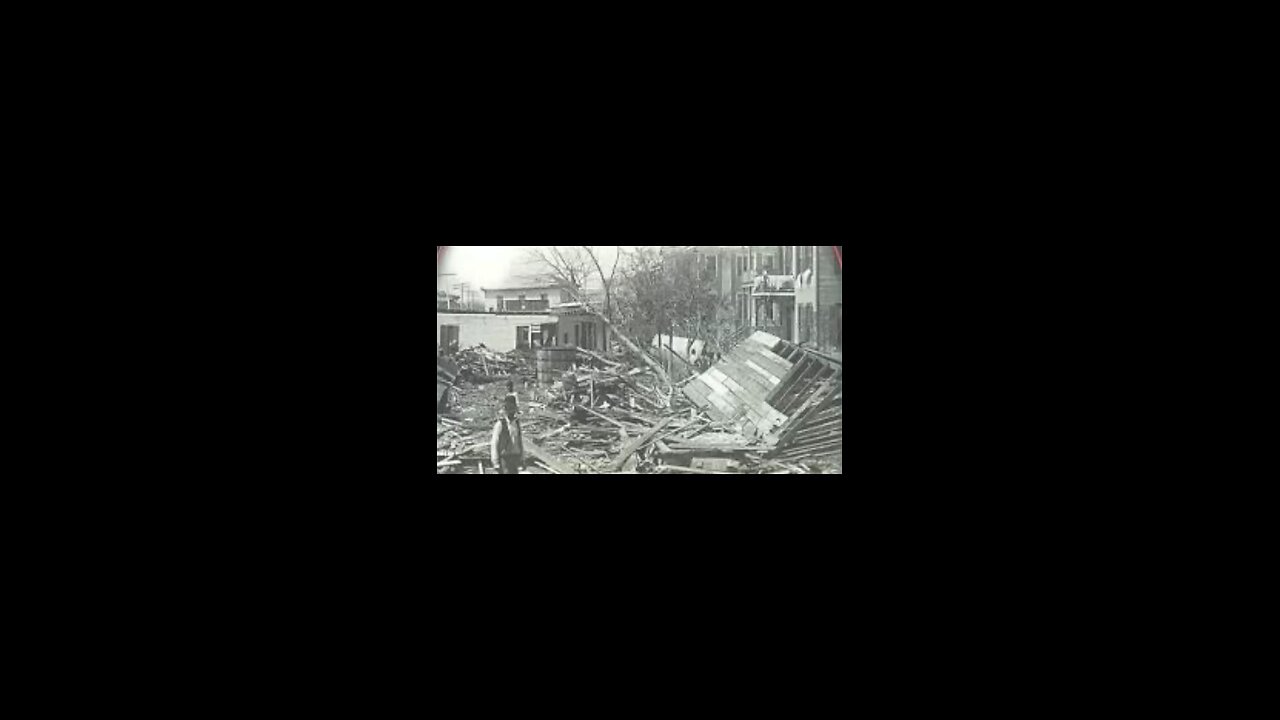Premium Only Content

Galveston Hurricane disaster
Good morning, students, faculty, and guests.
Today, I want to transport you back in time, to a bustling city on the Texas coast, a place known as the "Wall Street of the South," a vibrant hub of commerce and culture. This was Galveston, Texas, in the year 1900. It was a city confident in its prosperity, nestled on a barrier island, seemingly impervious to the whims of the Gulf of Mexico. But on a fateful day, September 8, 1900, that confidence was shattered, and Galveston experienced a disaster that would forever etch its name into the annals of American history – the Great Galveston Hurricane.
This isn't just a story about a storm; it's a profound lesson in humanity, resilience, and the relentless power of nature. It's a reminder of how vulnerable we can be, but also how remarkably strong we can become in the face of unimaginable adversity.
In the late summer of 1900, weather forecasting was in its infancy. There were no satellites to track swirling systems from space, no radar to pinpoint rainfall, no sophisticated computer models to predict their paths with precision. Warnings were rudimentary, often relying on observations from ships at sea and telegraph reports. Cuban meteorologists had been tracking a disturbance in the Caribbean, predicting it would move northwest into the Gulf. However, the U.S. Weather Bureau, then known as the Weather Bureau, had a different forecast, believing the storm would recurve northeast towards the mid-Atlantic. This divergence in opinion, coupled with a lack of real-time communication, left Galveston dangerously unaware of the impending catastrophe.
On the morning of Saturday, September 8th, the signs were ominous. The tide began to swell unusually high, flooding streets several blocks inland. Yet, for many Galvestonians, this was not entirely unfamiliar; the city was, after all, a low-lying island, barely nine feet above sea level at its highest point. There was a sense of complacency, a belief that the squalls would pass, as they always had. Few could fathom the true monster churning in the Gulf.
As the day progressed, the winds began to intensify, the skies turned a foreboding gray, and the rain became relentless. By mid-afternoon, the Category 4 hurricane unleashed its full fury upon the island. Winds exceeding 120 miles per hour, some estimates reaching 140 mph, tore through the city, but it was the storm surge that proved to be the deadliest force. A colossal wall of water, estimated to be 15 to 16 feet high, slammed into Galveston, sweeping over the entire island.
Imagine the scene: houses, many of them flimsily constructed, began to crumble like matchsticks. The very timbers of homes became deadly projectiles, carried by the surging water and hurled against other structures, creating a devastating domino effect. People, caught completely off guard, desperately sought refuge, some clinging to floating debris, others attempting to find higher ground in buildings that themselves were rapidly disintegrating.
Eyewitness accounts from that day are chilling. Survivors spoke of being tossed about in the churning water, grasping at anything that offered a chance of survival. One account describes a man reaching Galveston by swimming from pier to pier on a wrecked railroad trestle. Another tells of a family whose house was swept off its foundation, forcing them to break through a window as the structure collapsed around them. The water was waist-deep, then chest-deep, then swallowed entire homes. The sounds were horrific: the roar of the wind, the crash of collapsing buildings, the screams of those being swept away.
The devastation was almost incomprehensible. An estimated 8,000 to 12,000 people lost their lives, making the 1900 Galveston Hurricane the deadliest natural disaster in U.S. history. Two-thirds of the city's structures, including over 3,600 homes, were completely destroyed. Public buildings, hospitals, and schools lay in ruins. The city's vital infrastructure – telephone and telegraph lines, railroad tracks – was obliterated, isolating Galveston from the outside world. The sheer volume of human suffering was immense. Bodies were scattered everywhere, buried under mountains of debris, or washed out to sea.
In the immediate aftermath, the survivors faced a grim reality. They were without drinking water, proper shelter, or adequate food. The air was thick with the stench of death and decay. Relief efforts were slow to arrive due to the destruction of communication and transportation lines. But even amidst such desolation, the human spirit of resilience began to emerge. Survivors helped each other, forming makeshift crews to clear debris and search for the missing.
What happened next is a testament to the indomitable will of the people of Galveston. Instead of abandoning their city, they embarked on an audacious and unprecedented plan to protect it from future storms. Within a decade, they undertook two monumental engineering feats:
First, they constructed the Galveston Seawall. This massive concrete barrier, 17 feet high and 15 feet thick at its base, was built to stand against the mighty Gulf. Initially 3.5 miles long, it has since been extended to over 10 miles.
Second, and perhaps even more astonishing, they literally raised the elevation of the entire city. Over 500 city blocks were lifted anywhere from 8 to 17 feet. This involved an incredible process: structures were placed on stilts and jackscrews, and millions of cubic yards of sand were dredged from the ship channel and pumped underneath the buildings, filling in the newly created space. Imagine the scale of this undertaking – homes, businesses, streets, and utilities, all meticulously lifted to a safer elevation.
These efforts proved successful. In 1915, another powerful hurricane struck Galveston, but thanks to the seawall and the raised grade, the devastation was significantly less. While the city sustained flooding, the catastrophic loss of life seen in 1900 was avoided.
The Galveston Hurricane of 1900 stands as a stark reminder of our vulnerability to nature's power. It taught invaluable lessons about hurricane preparedness, the importance of robust warning systems, and the need for resilient infrastructure in coastal communities. But more than that, it is a story of human courage, ingenuity, and an unwavering commitment to rebuild and adapt in the face of unimaginable loss.
As you navigate your own lives and face challenges, remember the spirit of Galveston. Remember that even in the darkest hours, humanity's capacity for resilience, innovation, and community can pave the way for recovery and a stronger future. Thank you.
-
 LIVE
LIVE
SpartakusLIVE
7 hours ago#1 HERO of the PEOPLE || Ending the Week with FUN, WINS, and LAUGHS
461 watching -
 3:52:22
3:52:22
SynthTrax & DJ Cheezus Livestreams
16 hours agoFriday Night Synthwave 80s 90s Electronica and more DJ MIX Livestream THE FLOATING WORLD / Variety Music Edition
30.3K2 -
 LIVE
LIVE
Eternal_Spartan
13 hours ago🟢 Eternal Spartan Plays Destiny 2 | FPS Friday | | USMC Veteran
296 watching -
 2:04:11
2:04:11
MattMorseTV
7 hours ago $15.34 earned🔴The UK just hit ROCK BOTTOM.🔴
64K152 -
 LIVE
LIVE
iCheapshot
5 hours ago $2.02 earnedBack From Vacation! | Checking Out Skate Maybe Some Boarderlands 4
465 watching -
 3:08:37
3:08:37
Jorba4
4 hours ago🔴Live-Jorba4- Borderlands w/ The TRIBE
42.3K -
 54:43
54:43
Glenn Greenwald
8 hours agoGlenn Reacts to Netanyahu's UN Speech; PLUS: Q&A on Trump's Russia/Ukraine Policy, the Tom Homan Investigation, and More | SYSTEM UPDATE #522
87.5K48 -
 43:54
43:54
Donald Trump Jr.
7 hours agoJames and the Giant Breach, Plus Explosive J6 Revelations | TRIGGERED Ep.277
167K183 -
 4:45:01
4:45:01
MadHouse_
7 hours agoFRIEND FRIDAY! - Garys Mod ? im pretty sure im gonna lose at this game
29.8K5 -
 2:26:51
2:26:51
blackfox87
6 hours agoBorderlands Grind Continues | PREMIUM CREATOR | #DisabledVeteran
27.9K1